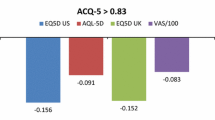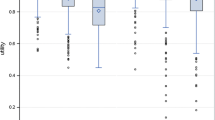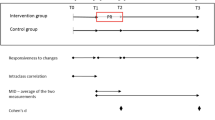Abstract
Objective
A goal of asthma management is to improve the patient’s health-related quality of life (HRQL). However, it is unclear whether HRQL instruments can discriminate across asthma control measures. The objective of this study was to evaluate the validity of generic and condition-specific preference-based instruments, in terms of their ability to distinguish asthma control.
Methods
Asthma patients (n = 157) completed three generic preference-based instruments: the Health Utility Index Mark 3 (HUI-3), the EuroQol (EQ-5D), and the Short Form 6D (SF-6D) and two condition-specific questionnaires: the standardized Asthma Quality of Life Questionnaire (AQLQ(S)) and the Asthma Control Questionnaire (ACQ). The AQLQ(S) scores were converted into the condition-specific preference-based scores: the Asthma Quality of Life Utility Index (AQL-5D).
Results
The preference-based instruments were generally able to discriminate across control measures, such as ACQ scores and magnitude of asthma medication, but were not able to discriminate for self-reported control and severity levels. These instruments also correlated with most control measures (r = 0.32–0.37). Significant relationships between AQL-5D scores and all control variables were observed.
Conclusions
Overall, the AQL-5D discriminated across all levels of asthma control. The HUI-3, the EQ-5D, and the SF-6D differentiated between the highest and lowest levels of control but could not discriminate between the moderate levels.

Similar content being viewed by others
Abbreviations
- ACQ:
-
Asthma control questionnaire
- ANOVA:
-
Analysis of variance
- AQL-5D:
-
Asthma quality of life utility index
- AQLQ:
-
Asthma quality of life questionnaire
- AQLQ(S):
-
Standardized version of the asthma quality of life questionnaire
- BC:
-
British Columbia
- EQ-5D:
-
EuroQol
- FEV1 :
-
Forced expired volume in the first second
- HRQL:
-
Health-related quality of life
- HUI:
-
Health utility index
- QALY:
-
Quality-adjusted life year
- QOL:
-
Quality of life
- SA:
-
Short-acting
- SF-6D:
-
Short Form 6D
- SG:
-
Standard gamble
- SGRQ:
-
St. George’s respiratory questionnaire
- TTO:
-
Time trade-off
- VAS:
-
Visual analogue scale
References
Statistics Canada. (2001). National population health survey (Online). Retrieved June 20, 2006, from http://www40.statcan.ca/101/cst01/health50a.htm.
Streiner, D. L., & Norman, G. R. (1995). Health measurement scales: A practical guide to their development and use. New York: Oxford University Press.
Bateman, E. D., Boushey, H. A., Bousquet, J., Busse, W. W., Clark, T. J., Pauwels, R. A., et al. (2004). Can guideline-defined asthma control be achieved? The gaining optimal asthma controL study. American Journal of Respiratory and Critical Care Medicine, 170, 836–844.
O’Byrne, P. M., Bisgaard, H., Godard, P. P., Pistolesi, M., Palmqvist, M., Zhu, Y., et al. (2005). Budesonide/formoterol combination therapy as both maintenance and reliever medication in asthma. American Journal of Respiratory and Critical Care Medicine, 171, 129–136.
Cockcroft, D. W., & Swystun, V. A. (1996). Asthma control versus asthma severity. Journal of Allergy and Clinical Immunology, 98, 1016–1018.
Juniper, E., Guyatt, G., & Epstein, R. (1992). Evaluation of impairment of health related quality of life in asthma: Development of a questionnaire for use in clinical trials. Thorax, 47, 76–83.
Juniper, E. F., Guyatt, G. H., Ferrie, P. J., & Griffith, L. E. (1993). Measuring quality of life in asthma. American Review of Respiratory Diseases, 147, 832–838.
Feeny, D., Furlong, W., Torrance, G. W., Goldsmith, C. H., Zhu, Z., DePauw, S., et al. (2002). Multiattribute and single-attribute utility functions for the health utilities index mark 3 system. Medical Care, 40, 113–128.
The EuroQol Group. (1990). EuroQoL—a new facility for the measurement of health-related quality of life. Health Policy, 16, 199–208.
Brazier, J., Roberts, J., & Deverill, M. (2002). The estimation of a preference-based measure of health from the SF-36. Journal of Health Economics, 21, 271–292.
Weinstein, M. C., Siegel, J. E., Gold, M. R., Kamlet, M. S., & Russell, L. B. (1996). Recommendations of the panel on cost-effectiveness in health and medicine. Journal of the American Medical Association, 276, 1253–1258.
Neumann, P. J., Goldie, S. J., & Weinstein, M. C. (2000). Preference-based measures in economic evaluation in health care. Annual Review of Public Health, 21, 587–611.
Brazier, J., & Deverill, M. (1999). A checklist for judging preference-based measures of health-related quality of life: learning from psychometrics. Health Economics, 8, 41–51.
Guyatt, G. H., King, D. R., Feeny, D. H., Stubbing, D., & Goldstein, R. S. (1999). Generic and specific measurement of health-related quality of life in a clinical trial of respiratory rehabilitation. Journal of Clinical Epidemiology, 52(3), 187–192.
Revicki, D. A., Leidy, N. K., Brennan-Diemer, F., Sorensen, S., & Togias, A. (1998). Development and preliminary validation of the multiattibute rhinitis symptom utility index. Quality of Life Research, 7, 693–702.
Revicki, D. A., Leidy, N. K., Brennan-Diemer, F., Sorensen, S., & Togias, A. (1998). Intergrating patient preferences into health outcomes assessment: The multiattribute asthma symptom utility index. Chest, 114, 998–1007.
Sculpher, M. (2001). Using economic evaluations to reduce the burden of asthma and chronic obstructive pulmonary disease. Pharmacoeconomics, 19, 21–25.
Paltiel, A. D., Fuhlbrigge, A. L., Kitch, B. T., Liljas, B., Weiss, S. T., Neumann, P. J., et al. (2001). Cost-effectiveness of inhaled corticosteroids in adults with mild-to-moderate asthma: Results from the asthma policy model. Journal of Allergy and Clinical Immunology, 108, 39–46.
van den Boom, G., Rutten-van Molken, M. P., Molema, J., Tirimanna, P. R., van Weel, C., & van Schayck, C. P. (2001). The cost effectiveness of early treatment with fluticasone propionate 250 microg twice a day in subjects with obstructive airway disease. Results of the DIMCA program. American Journal of Respiratory and Critical Care Medicine, 164, 2057–2066.
Schermer, T. R., Thoonen, B. P., van den Boom, G., Akkermans, R. P., Grol, R. P., Folgering, H. T., et al. (2002). Randomized controlled economic evaluation of asthma self-management in primary health care. American Journal of Respiratory and Critical Care Medicine, 166, 1062–1072.
Stahl, E., Postma, D. S., Svensson, K., Tattersfield, A. E., Eivindson, A., Schreurs, A., et al. (2003). Formoterol used as needed improves health-related quality of life in asthmatic patients uncontrolled with inhaled corticosteroids. Respiratory Medicine, 97, 1061–1066.
Moy, M. L., Fuhlbrigge, A. L., Blumenschein, K., Chapman, R. H., Zillich, A. J., Kuntz, K. M., et al. (2004). Association between preference-based health-related quality of life and asthma severity. Annual Allergy, Asthma, and Immunology, 92, 329–334.
Szende, A., Svensson, K., Ståhl, E., Mészáros, Á., & Berta, G. Y. (2004). Psychometric and utility-based measures of health status of asthmatic patients with different disease control level. Pharmacoeconomics, 22, 537–547.
Global Initiative for Asthma. (1998). Pocket guide for asthma management and prevention. Bethesda (MD): National Institute of Health NIH Pub. No. 96-3569B.
Jones, P. W., Quirk, F. A., Baveystock, C. M., & Littlejohns, P. (1992). A set-complete measure of health status for chronic airflow limitation. The St. George’s respiratory questionnaire. American Review of Respiratory Diseases, 145, 1321–1327.
Sanjuás, C., Alonson, J., Prieto, L., Ferrer, M., Broquetas, J. M., & Antó, J. M. (2002). Health-related quality of life in asthma: A comparison between St. George’s respiratory questionnaire and asthma quality of life questionnaire. Quality of Life Research, 11, 729–738.
Juniper, E. F., O’Byrne, P. M., & Roberts, J. N. (2001). Measuring asthma control in group studies: Do we need airway caliber and rescue beta2-agonist use? Respiratory Medicine, 95, 319–323.
British Thoracic Society, British Paediatric Association, Royal College of Physicians of London, King’s Fund Centre, National Asthma Campaign, Royal College of General Practitioners et al. (1993). Guidelines on the management of asthma. Thorax, 48(Suppl 2), S1–S24.
Boulet, L.-P., Becker, A., Bérubé, D., Beveridge, R., & Ernst, R. (1999). Canadian asthma consensus report, 1999. Canadian Medical Association Journal, 161(11 Suppl), S1–S62.
Yang, Y., Tsuchiya, A., Brazier, J. E., & Young, T. A. (2007). Estimating a preference-based single index from the Asthma Quality of Life Questionnaire (AQLQ). Discussion paper No. 07/02 from Health Economics and Decision Science, School of Health and Related Research, Sheffield, United Kingdom.
Lynd, L. D., Guh, D. P., Paré, P. D., & Anis, A. H. (2002). Patterns of inhaled asthma medication use: A 3-year longitudinal analysis of prescription claims data from British Columbia, Canada. Chest, 122(6), 1973–1981.
Maddigan, S. L., Feeny, D. H., & Johnson, J. A. (2005). Health-related quality of life deficits associated with diabetes and comorbidites in a Canadian national population health survey. Quality of Life Research, 14(5), 1311–1320.
Walters, S. J., & Brazier, J. E. (2003). What is the relationship between the minimally important difference and health state utility values? The case of the SF-6D. Health Quality of Life Outcomes, 1(1), 4–13.
Crapo, R. O., Morris, A. H., & Gardner, R. M. (1981). Reference spirometric values using techniques and equipment that meet ATS recommendations. American Review of Respiratory Diseases, 123, 659–664.
American Thoracic Society. (1987). Standardization of spirometry–1987 update. Statement of the American thoracic society. American Review of Respiratory Diseases, 136, 1285–1298.
Juniper, E. F., Buist, A. S., Cox, F. M., Ferrie, P. J., & King, D. R. (1999). Validation of a standardized version of the asthma quality of life questionnaire. Chest, 115, 1265–1270.
Juniper, E. F., O’Byrne, P. M., Guyatt, G. H., Ferrie, P. J., & King, D. R. (1999). Development and validation of a questionnaire to measure asthma control. European Respiratory Journal, 14(4), 902–907.
Dolan, P., & Gudex, C. (1995). Time preference, duration and health state valuations. Health Economics, 4, 289–299.
Young, T. A., Yang, Y., Tsuchiya, A., & Brazier, J. E. (2007). The use of Rasch analysis as a tool in the construction of preference-based measure: The case of AQLQ. Discussion paper No. 07/02 from Health Economics and Decision Science, School of Health and Related Research, Sheffield, United Kingdom.
Cohen, J. (1992). A power primer. Psychology Bulletin, 112, 155–159.
Brazier, J., Akehurst, R., Brennan, A., Dolan, P., Claxton, K., McCabe, C., et al. (2005). Should patients have a greater role in valuing health states? Applied Health Economics and Health Policy, 4, 201–208.
Bleichrodt, H., & Johannesson, M. (1997). Standard gamble, time trade-off and rating scale: Experimental results on the ranking properties of QALYs. Journal of Health Economics, 16, 155–175.
Kopec, J. A., & Willison, K. D. (2003). A comparative review of four preference-weighted measures of health-related quality of life. Journal of Clinical Epidemiology, 56, 317–332.
Drummond, M. F., Sculpher, M. J., Torrance, G. W., O’Brien, B. J., & Stoddart, G. L. (2005). Methods for the economic evaluation of health care programmes. New York: Oxford University Press.
Acknowledgements
We would like to acknowledge the British Columbia Lung Association and the Michael Smith Foundation for Health Research for their financial support of this study. Presently, Drs. Lynd and Marra are both recipients of a Michael Smith Foundation for Health Research scholar award. In addition, Dr. Lynd is a Canadian Institute for Health Research new investigator award recipient and Dr. Marra holds a Government of Canada Research Chair in Pharmaceutical Outcomes. Drs. Kopec and FitzGerald hold a Senior Scholar Award and a Distinguished Scholar Award, both from the Michael Smith Foundation for Health Research, respectively. At the time of the study, Ms. McTaggart-Cowan was a recipient of a Michael Smith Foundation for Health Research trainee award. We would also like to thank the participation of the asthma patients in this study and the clinical support by the following respiratory therapists and technicians: Bev Beaudin, Linda Hui, Louella Markortoff, and Tanja Teofilovic. Finally, we acknowledge the reviewers for their constructive comments.
Author information
Authors and Affiliations
Corresponding author
Rights and permissions
About this article
Cite this article
McTaggart-Cowan, H.M., Marra, C.A., Yang, Y. et al. The validity of generic and condition-specific preference-based instruments: the ability to discriminate asthma control status. Qual Life Res 17, 453–462 (2008). https://doi.org/10.1007/s11136-008-9309-6
Received:
Accepted:
Published:
Issue Date:
DOI: https://doi.org/10.1007/s11136-008-9309-6




